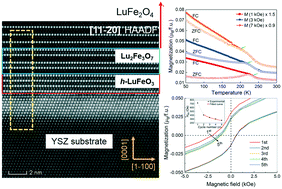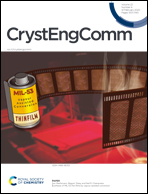Magnetic and electrical properties of LuFe2O4 epitaxial thin films with a self-assembled interface structure†
Abstract
LuFe2O4 has been the most extensively studied among a series of RFe2O4 (R = Sc, Y, In and Dy to Lu) compounds, which possess both dielectric and magnetic orderings originating in equal numbers of Fe2+ and Fe3+ ions in a triangular lattice. We have prepared LuFe2O4 thin films epitaxially grown on a (111)-oriented YSZ (yttria-stabilized zirconia) substrate via a pulsed laser deposition method and found that the resultant thin film comprises a curious self-assembled interface structure. Our structural analysis at an atomic level by using high-angle annular dark-field scanning transmission electron microscopy and energy dispersive X-ray spectrometry reveals that very thin layers of LuFe2O4 lacking Fe–O layers, corresponding to the hexagonal LuFeO3 and Lu2Fe3O7 compositions, are formed at the interface between the c-axis oriented LuFe2O4 thin film and YSZ substrate with a Lu-rich region just on the surface of the substrate. Such an interfacial structure leads to an exchange bias effect peculiarly observed for an interface formed by different types of magnetic materials. The LuFe2O4 thin film itself shows spin glass transition similar to bulk LuFe2O4 with an off-stoichiometric oxygen ratio. Also, a change in electronic transport behavior between Arrhenius-type and variable range hopping schemes has been observed in the temperature dependence of electrical resistivity around the three-dimensional charge ordering temperature.



 Please wait while we load your content...
Please wait while we load your content...